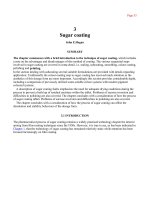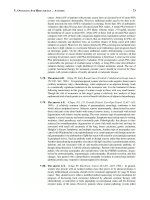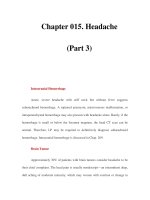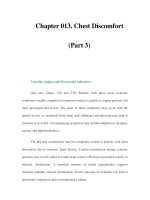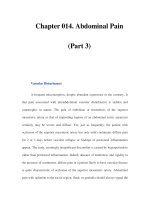BASIC HUMAN ANATOMY - PART 3 pdf
Bạn đang xem bản rút gọn của tài liệu. Xem và tải ngay bản đầy đủ của tài liệu tại đây (232.22 KB, 25 trang )
MD0006 3-9
EXERCISES, LESSON 3
REQUIREMENT. The following exercises are to be answered by completing the
incomplete statement or by writing the answer in the space provided at the end of the
question.
After you have completed all the exercises, turn to "Solutions to Exercises," at the
end of the lesson and check your answers.
1. What is included in the integumentary system?
2. What is another name for the integument proper?
3. What are three types of integumentary derivatives?
4. What is a fascia?
5. What is the subcutaneous layer (superficial fascia)?
6. Where are deep fasciae found in the body?
7. What is the investing deep fascia?
8. What is the outer layer of the skin?
What is the inner and deeper layer of the skin?
MD0006 3-10
9. What type of tissue makes up the epidermis?
What is the basic structure of the innermost layer of the epidermis?
What are characteristics of cells found in the outermost layers of the
epidermis?
10. What type of tissue makes up the dermis?
What are papillae and what is their function?
What other structures are found in the dermis?
11. A hair follicle is formed by the .
At the base of the hair follicle is the .
The hair shaft grows out from the .
The hair shaft is made of cells from the .
12. Sweat glands consist of .
13. Sebaceous glands produce .
Its function is to .
The sebaceous glands are usually found as a part of the walls of
.
14. In mammary glands, milk ducts connect each nipple with
.
What types of connective tissue fill in the spaces?
15. Nails are found on the ends of the .
Nails help to protect .
The nail itself is made up of .
The nails grow continuously from their .
MD0006 3-11
16. The term serous refers to a .
Serous cavities are .
These cavities serve as .
17. Each bursa is a small sac located between ,
usually a muscle moving over a . The bursa reduces the between
two structures. The serous membrane lining the cavity within a bursa is a and
it secretes a into the serous cavity.
18. Each lung is encased in a serous cavity called the . The heart lies in
a serous cavity called the . The intestines move freely within the
cavity.
Check Your Answers on Next Page
MD0006 3-12
SOLUTIONS TO EXERCISES, LESSON 3
1. The integumentary system includes the integument proper (skin) and the
integumentary derivatives (hairs, nails, and glands of the skin). (para 3-1a)
2. Another name for the integument proper is the skin. (para 3-1a)
3. Three types of integumentary derivatives are the hair, nails, and various
glands of the skin. (para 3-1a)
4. A fascia is a sheet or collection of fibrous connective tissue (FCT).
(para 3-1b)
5. The subcutaneous layer (superficial fascia) is the connective tissue which lies
immediately beneath the skin. (para 3-1b)
6. Deep fasciae are found as envelopes for muscles and other organs and they
fill spaces. (para 3-1b)
7. The investing deep fascia is the third envelope of the whole body beneath the
skin and the subcutaneous layer. (para 3-1b)
8. The outer layer of the skin is the epidermis. The inner and deeper layer of
skin is the dermis. (para 3-3)
9. The epidermis is a stratified squamous epithelium.
The basic structure of the innermost layer of the epidermis is a single layer of
columnar-type epithelial cells.
The cells found in the outermost layers of the epidermis are transparent,
flattened, dead, cornified, and without nuclei. (para 3-3a)
10. The dermis is dense FCT consisting of white and yellow fibers.
Papillae are finger-like projections of the dermis that extend into the
epidermis.
Papillae prevent the dermis and epidermis from sliding on each other.
Other structures found in the dermis include blood vessels, lymph vessels,
nerve endings, hair follicles, and glands. (para 3-3b)
11. A hair follicle is formed by the extension of the skin (dermis and epidermis)
deeper into the surface of the body. At the base of the hair follicle is the hair
root. The hair shaft grows out from the root. The hair shaft is made of cells
from the outermost layers of the epidermis. (paras 3-5a, b)
12. Sweat glands consist of a coiled secretory portion and a wavy duct which
leads to the surface of the skin. (para 3-6a)
MD0006 3-13
13. Sebaceous glands produce an oily substance. Its function is to lubricate the
skin and hairs and to keep them flexible. The sebaceous glands are usually
found as a part of the walls of hair follicles. (para 3-6b)
14. In mammary glands, milk ducts connect each nipple with lobes of glandular
tissue. Fat and fibrous CT fill in the spaces among the lobes. (para 3-6c)
15. Nails are found on the ends of the digits. Nails help to protect the ends of
these digits. The nail itself is made up of cornified (hardened) outer cell layers
of the epidermis. The nails grow continuously from their roots. (para 3-7)
16. The term serous refers to a watery-type fluid. Serous cavities are sacs lined
with serous membranes. These cavities serve as lubricating devices.
(para 3-12)
17. Each bursa is a small sac located between two moving structures, usually a
muscle moving over a bony surface. The bursa reduces the friction between
the two structures. The serous membrane lining the cavity within a bursa is a
simple squamous epithelium and it secretes a serous fluid into the serous
cavity. (para 3-13)
18. Each lung is encased in a serous cavity called the pleural cavity. The heart
lies in a serous cavity called the pericardial cavity, the intestines move freely
within the peritoneal cavity. (para 3-14a)
End of Lesson 3
MD0006 4-1
LESSON ASSIGNMENT
LESSON 4 The Human Skeletal System.
TEXT ASSIGNMENT Paragraphs 4-1 through 4-14.
LESSON OBJECTIVES After completing this lesson, you should be able to:
4-1. Define skeleton.
4-2. Name four functions of the human skeleton.
4-3. Name the layers and describe the basic
structure of an individual bone, name and
describe the parts of an individual long bone,
and describe the periosteum and the blood
supply of an individual bone.
4-4. Describe the development of an individual
bone.
4-5. Name four types of bones by shape.
4-6. Describe major categories used in
classification of joints.
4-7. Name the major parts of a "typical" synovial
joint.
4-8. Name and describe classifications of synovial
joints according to the kind of motion and
number of axes.
4-9. Name and define the two major subdivisions of
the skeleton.
4-10. Describe a typical vertebra. Name the regions
of the vertebral column and give the number of
vertebrae in each region. Describe the
intervertebral discs and ligaments that hold
vertebrae together.
4-11. Describe the thoracic cage.
4-12. Describe the skull.
MD0006 4-2
4-13. Describe the general pattern of the bones of
the upper and lower members.
SUGGESTION After completing the assignment, complete the
exercises at the end of this lesson. These exercises
will help you to achieve the lesson objectives.
MD0006 4-3
LESSON 4
THE HUMAN SKELETAL SYSTEM
Section I. GENERAL
4-1. INTRODUCTION
The skeleton serves as a support or framework of the human body. It is a
combination of bones joined together.
4-2. FUNCTIONS OF THE HUMAN SKELETON
The human skeleton serves the following functions:
a. Bodily Support. The skeletal system provides a framework for the human
body.
b. Protection. The skeleton protects certain soft structures within the human
body. An example is the skull, which surrounds the brain.
c. Motion. Muscles are attached to and move the bones. Bones provide
leverage for motion.
d. Formation of Blood Cells (Hematopoiesis). Blood cells are manufactured
in the red bone marrow, mainly found in flat bones.
4-3. PRIMARY STUDY AREAS
In this text, we study the skeletal system from four different viewpoints:
a. Bone As Tissues. This aspect of the human skeletal system was discussed
in paragraph 2-11 and will not be further discussed here.
b. Bone As An Individual Organ. Section II of this lesson discusses bone as
an individual organ.
c. Articulations (Joints) Arthrology. Section III of this lesson introduces the
study of joints, or arthrology.
d. The Human Skeleton. Section IV of this lesson discusses the human
skeleton as a whole in terms of its major subdivisions.
MD0006 4-4
Section II. BONE AS AN INDIVIDUAL ORGAN
4-4. BASIC STRUCTURE OF AN INDIVIDUAL BONE
See figure 4-1 for the basic structure of an individual bone.
Figure 4-1. A mature long bone (femur).
MD0006 4-5
a. Use of Bony Tissues to Form an Individual Bone.
(1) Cortex. The cortex is the outer layer of the individual bone. It is made up
of compact (dense) bony tissue.
(2) Medulla. The medulla is the central portion of the individual bone. It
generally consists of cancellous (spongy) bone tissue. In some bones, particularly long
bones, the medulla may include a space without any bony tissue. This space is called
the medullary or marrow cavity.
b. Marrow. Marrow serves as a filler of the inside of bones. There are two
types of bone marrow yellow bone marrow and red bone marrow. Yellow bone marrow
is mostly yellow fat tissue. Red bone marrow is the only site in adults for the formation
of red blood cells (hematopoiesis).
c. Named Parts of an Individual Long Bone.
(1) Shaft (diaphysis). The shaft is the central portion of a long bone. Here,
the cortex is thickened as required by applied physical stresses.
(2) Ends (epiphyses). The ends of long bones are made up mainly of
cancellous (spongy) bone tissue. An articular cartilage covers each area where a bone
contacts another bone(s). This articular cartilage is made up of hyaline cartilage tissue
and provides a smooth surface for motions.
d. Periosteum. The periosteum is a covering of the bone surface area not
covered by articular cartilage. It has two layers the innermost layer and the fibrous
layer.
(1) The innermost layer, which lies against the outer surface of the bone,
consists of bone-forming cells (osteoblasts). It is the osteogenic (bone-forming) layer.
(2) The outermost layer is a FCT (fibrous connective tissue) layer.
(3) The periosteum is well supplied with blood vessels and sensory-type
nervous tissue.
e. Blood Supply of an Individual Bone. A system of blood vessels enters and
spreads out through the periosteum. Additional blood vessels, called "nutrient vessels,"
penetrate the cortex of the bone and spread out through the marrow. The passageways
for penetration of these vessels are called the nutrient canals.
MD0006 4-6
4-5. DEVELOPMENT OF AN INDIVIDUAL BONE
a. General. The human skeleton is "preformed" in the early fetus, but the early
form is not of bony material. There are two types of bones according to their preformed
basis: membranous bones and cartilage bones. These are in the location and have the
general shape of the adult bones they will later become.
(1) Membranous bones. The outer skull bones are an example of
membranous bones. Osteoblasts invade a membrane to form a center of ossification
(formation of bone). Bone-forming activity spreads out from this center until a full bone
plate is formed.
(2) Cartilage bones. In the fetus, many bones, for example, long bones, exist
first as models formed of cartilage.
b. Sesamoid Bones. Sesamoid bones are small masses of bone that develop
in tendons at points where great forces are applied to the tendons. The most obvious
and largest sesamoid bone is the patella, or kneecap.
c. Ossification Centers. An ossification center is a growing mass of actual
bone within the preformed material, as noted above.
(1) Initial bone formation involves destruction of the preforming material and
replacement with bony tissue.
(2) In the development of long bones, there are two types of ossification
centers:
(a) Diaphyseal in the shaft region.
(b) Epiphyseal in the end(s).
(3) As a long bone grows in length, the preforming material grows faster than
the ossification center can tear it down. Ultimately, with time, the preforming material is
overcome and growth ceases.
d. Growth in Bone Width. A bone grows wider through the activity of the
osteogenic layer of the periosteum. Remember, the periosteum covers most of the
outer surface of the bone.
4-6. TYPES OF BONES
Bones of the skeleton can be grouped into the following major types: long, short,
flat, and irregular. Each type has a somewhat different construction pattern.
MD0006 4-7
a. Long Bones. The basic structure of a long bone is illustrated in figure 4-1
and discussed in paragraph 4-4. Example: femur.
b. Short Bones. The short bones, such as those of the wrist and feet, have a
thin layer of compact bone surrounding an inner mass of spongy bone.
Example: carpal bones.
c. Flat Bones. The flat bones are constructed with two plates of compact bone,
which enclose between them a layer of spongy bone. The spongy bone is richly
supplied with blood vessels and red marrow. Example: the cranial frontal bone.
d. Irregular Bones. The irregular bones are those that do not fit into the three
categories above. Example: a vertebra.
Section III. ARTHROLOGY THE STUDY OF JOINTS (ARTICULATIONS)
4-7. DEFINITION
A joint, or articulation, is the location where two or more bones meet.
4-8. TYPES OF JOINTS
Joints are classified according to the kind of material holding the bones together
and the relative freedom and kind of motion at the particular joint.
a. Fibrous Joints. Varying degrees of motion, from none to some, are possible
in fibrous joints.
(1) Syndesmosis. When the bones are held together by FCT (fibrous
connective tissue), the joint is referred to as a syndesmosis.
SYN = together
DESMOS = fiber (a tying material)
Example: The inferior tibio-fibular joint.
(2) Suture. When the bones are quite close together with a minimum of FCT,
the joint is known as a suture. Example: the joints between the cranial bones.
b. Bony Joints. Should the bones be united by bony material, the joint is
referred to as a synosteosis.
SYN = together
OSTEO = bone
MD0006 4-8
Example: The frontal bone. (The frontal bone of the skull is actually a bony fusion of
two bones. Approximately 10 percent of the time, this fusion fails to take place; the
original suture between the bones remains and is called a metopic suture.)
c. Cartilagenous Joints. These are also nonmovable joints.
(1) Synchondrosis. A cartilagenous joint in which the bones are held
together by hyaline cartilage.
SYN = together
CHONDRO = cartilage
Example: Epiphyseal plate.
(2) Symphysis. A cartilagenous joint in which the bones are held together by
a disc of fibrocartilage.
Example: Pubic symphysis.
d. Synovial Joints. In the synovial type of joints, the bones move on one
another so as to allow various motions of the body parts. The "ovial" part of the name
refers to the fact that the fluid substance seen in this type of joint appeared to the old
anatomists to be like raw egg white (ovum = egg).
4-9. A "TYPICAL" SYNOVIAL JOINT
A "typical" synovial joint is one which has parts common to all of the synovial
joints. In a sense, it is imaginary. It is not actually a specific synovial joint. It is a
composite. It is illustrated in figure 4-2. The "typical" synovial joint has the following
parts:
a. Bones. Bones are the levers of motion. They are the site of attachment for
skeletal muscles.
b. Articular Cartilages. The "contact" points of the bones are usually covered
with a layer of lubricated cartilage. Where these cartilages end, the synovial
membranes begin. Cartilages provide a smooth surface to reduce friction.
MD0006 4-9
Figure 4-2. A "typical synovial joint: diagrammatic.
c. Synovial Membrane, Space, and Fluid.
(1) Synovial membrane. The synovial membrane lines the inner surface of
the capsule. It secretes synovial fluid into the synovial space.
(2) Synovial space. Figure 4-2 exaggerates the amount of space between
the bones. The space within the capsule allows movement.
(3) Synovial fluid. Synovial fluid is a colorless, viscous fluid similar in
consistency to raw egg white. It lubricates the articulation.
MD0006 4-10
d. Capsule. The "typical" synovial articulation is surrounded by a sleeve of
dense FCT known as the capsule. The capsule encloses the articulation.
e. Ligaments. Primarily, ligaments hold bones together. Ligaments also may
help restrain motion in certain directions and stabilize the articulation.
f. Muscles. Skeletal muscles apply the forces to produce a given motion.
NOTE: See table 4-1 for a summary of the structures in a "typical" synovial
articulation, the tissues composing each structure, and the actions attributed
to each structure.
4-10. CLASSIFICATION OF SYNOVIAL JOINTS
Synovial joints are further classified according to the kind of motion and the
number of axes of motions used.
a. Uni-Axial Synovial Joints.
(1) In uni-axial synovial joints, motion occurs in only one plane. The joints of
the fingers (interphalangeal) flex and extend in the sagittal plane. These are commonly
referred to as hinge joints.
(2) If a single rotatory (rotational) motion occurs around a post-like structure,
the joint is a pivot joint. The atlas vertebra rotating around the dens (tooth like
projection) of the axis vertebra at the top of the neck (base of the skull) is a pivot joint.
b. Bi-Axial Synovial Joints. In bi-axial synovial joints, motion between the
bones occurs in two planes. Here the surface in contact is curved or rounded in two
directions.
(1) The proximal phalanx of a finger can flex and extend and move from side
to side on the rounded head of the metacarpal bone. This is the MP or
metacarpophalangeal joint.
(2) When the two surfaces are curved in directions at right angles to each
other, a shape similar to that of a cowboy's saddle is formed. This type of synovial joint
is called a saddle joint. In the human body, the saddle joint is located at the base of the
thumb.
MD0006 4-11
STRUCTURE TISSUE(S) FUNCTION(S)
1. BONE BONY (a) Serves as site of attachment for the
skeletal muscles.
(b) Serves as lever of motion.
2. ARTICULAR
CARTILAGE
HYALINE
CARTILAGE
Serves as smooth surface, over which motion
takes place.
3. FIBROUS
CAPSULE
DENSE FCT Encloses articulation.
4. SYNOVIAL
MEMBRANE
SIMPLE
SQUAMOUS
EPITHELIUM
(a) Lines capsule.
(b) Secretes synovial fluid into synovial
space.
5. SYNOVIAL
SPACE
- Frees articulation for motion.
6. SYNOVIAL
FLUID
SEROUS FLUID Lubricates articulation.
7. LIGAMENT (VERY) DENSE
FCT
Holds the bones together.
8. SKELETAL
MUSCLE
STRIATED
MUSCLE
FIBERS
Applies force to produce motion.
Table 4-1. The tissues and functions of structures of a "typical"
synovial articulation.
c. Multi-Axial Synovial Joints. In multi-axial joints, motion is possible in all
three planes of space.
(1) The ball-and-socket-type synovial joint has the freest motion in all
directions. A spherically rounded head (ball-like) fits into a receiving concavity (socket).
The hip joint is an example of the ball-and-socket type, with the spherical head of the
femur fitting into the cup or socket (acetabulum) of the pelvic bone.
MD0006 4-12
(2) In the plane joint, the contact surfaces of the bones are essentially flat.
These flat surfaces slide on one another (also called translatory motion). The
acromioclavicular joint of the shoulder region is an example of a plane joint.
4-11. THE ARTICULAR DISC
In three of the synovial joints of the human body, a special addition is seen. This
addition is known as an articular disc. The joints with articular discs are the temporo-
mandibular joint of the lower jaw, the sternoclavicular joint (at the sternum
(breastbone)), and the ulnocarpal joint of the distal end of the forearm.
a. An articular disc is a fibrocartilage plate. It is inserted between the articular
surfaces of the bones of a synovial joint. In this way, it divides the synovial space into
two spaces.
b. Joints having an articular disc are capable of having several different motions
occurring at the same time. Mechanically, there are really two joints together here.
Section IV. THE HUMAN SKELETON
4-12. GENERAL
a. The human skeleton (figures 4-3A and 4-3B) is a collection of individual
bones articulated (joined) together.
b. The major subdivisions of the skeleton are the axial skeleton and the
appendicular skeleton.
4-13. THE AXIAL SKELETON
The axial skeleton is the central framework of the human body. It includes the
skull, the vertebral column (spine), and the thoracic cage (chest or rib cage).
MD0006 4-13
Figure 4-3A. Anterior view of the human skeleton.
MD0006 4-14
Figure 4-3B. Posterior view of the human skeleton.
MD0006 4-15
a. Vertebral Column (Spine). The vertebral column, or spine, is made up of a
vertical series of bony blocks called vertebrae. These vertebrae are joined together in
such a way as to form a semiflexible rod. The spine is the central support for the trunk,
yet allows trunk movements.
(1) Anatomically and functionally, a typical vertebra (figure 4-4) is
constructed of two major parts:
(a) The vertebral body is a drum-shaped cylindrical mass. Its superior
and inferior surfaces are flat. Its function is primarily weight-bearing.
(b) The neural arch extends posteriorly, arching over and protecting the
spinal cord of the central nervous system. From the neural arch are several processes.
These processes serve as attachment areas for the trunk muscles. They also act as
levers during various trunk motions.
Figure 4-4. A typical vertebra (superior and side views.
(2) The vertebral column has 32-33 vertebrae, one on top of the other.
These vertebrae are arranged in regions. The vertebrae of each region have a
characteristic shape. The regions are as follows:
(a) Cervical (neck) region, with seven cervical vertebrae.
(b) Thoracic (chest) region, with 12 thoracic vertebrae.
(c) Lumbar (low back) region with five lumbar vertebrae.
MD0006 4-16
(d) The sacrum, which is a bony fusion of five sacral vertebrae.
(e) The coccyx (pronounced COCK-sicks, "tail"), with 3-4 coccygeal
vertebrae together.
(3) The vertebrae are held together in two ways:
(a) The intervertebral disc holds the bodies of adjacent vertebrae
together. The intervertebral disc is a fibrous ring with a soft center. This disc allows
the vertebral bodies to move on one another. This joint between the vertebral bodies is
a plane-type joint.
(b) The various parts of adjacent vertebrae are held together by
ligaments. A ligament is a dense FCT structure which extends from bone to bone.
These ligaments extend along the vertebral column from the base of the skull all the
way down to the coccyx.
(4) The spine has four curvatures in the adult human. In the cervical (neck)
region and the lumbar (low back) region, the spine curves forward. In the thoracic
(chest) region and the sacro-coccygeal (pelvic- sacrum and coccyx) region, the spine
curves backwards.
(5) When one examines the back of a person by sight and feel (palpation),
certain landmarks are observed.
(a) At the upper shoulder region in the midline, a knob can be seen and
felt. This is the tip of the spinous process of the seventh cervical vertebra. Since this is
the first vertebra from the top that can be easily palpated, this bony landmark is called
the vertebra prominens (the "prominent vertebra").
(b) From the vertebra prominens down to the beginning of the sacrum,
one can feel the tip of the spinous process of each vertebra.
b. The Thoracic (Rib) Cage. The rib cage (figure 4-5) forms a protective
enclosure for the vital organs contained within the thorax (chest) such as the heart and
lungs. It also allows the movements of breathing to take place.
MD0006 4-17
Figure 4-5. The human thorax with bones of the shoulder region.
(1) The sternum lies in the midline of the thorax anteriorly. It is made up of
three parts: the manubrium at the top, the body as the main part, and the xiphoid
process below. On the top of the manubrium is the jugular (sternal) notch, a common
landmark. The junction between the manubrium and the body is a joint called the
sternal angle. This sternal angle is an important landmark clinically because the second
rib attaches to the sternum at this junction. It is just a matter of simple counting after
identifying the second rib to know where you are on the thoracic wall.
(2) The rib cage consists of the 12 thoracic vertebrae, 12 pairs of ribs, and
the sternum. Each rib is curved laterally from back to front. All 12 pairs of ribs are
attached posteriorly to the thoracic vertebrae. The upper six pairs of ribs are attached
directly to the sternum by their costal cartilages. The seventh through tenth pairs of ribs
are attached indirectly to the sternum through their costal cartilages (by attaching to the
costal cartilage of the rib above). Rib pairs 11 and 12 do not attach to the sternum.
Instead, they are embedded in the trunk wall muscles.
c. The Skull. The skull (figure 4-6) is the bony framework (skeleton) of the head
region. It has two major subdivisions: the cranium which encases and protects the
brain and the facial skeleton which is involved with the beginnings of the digestive and
respiratory systems. The special sense organs (eyes, ears, etc.) are included and
protected within the skull.
MD0006 4-18
Figure 4-6. The human skull (front and side views).
MD0006 4-19
(1) The bones of the cranium form a spherical case around the brain. With
age, the sutures between the cranial bones become more solid. The cranium has a
base with several openings for the passage of blood vessels and nerves. The vault (or
calvaria) is made up of flat bones arching over and covering the brain.
(2) The facial skeleton consists of bones which surround the nose and the
mouth. These are mainly flat and irregular bones. Bones of the facial skeleton also
form part of the orbit of each eye.
(3) Certain bones of the skull have air-filled spaces called the paranasal
sinuses.
(4) The upper jaw (maxilla) and the lower jaw (mandible) are parts of the
facial skeleton which surround the mouth.
(5) The hyoid bone is located at the junction between the head and the neck.
It is not articulated directly with the other bones. It is held in place and moved
around by groups of muscles above and below. The root of the tongue is attached to
its upper anterior surface. The larynx is suspended from its inferior surface. These
three structures, together, form the hyoid complex. This complex is a functional unit for
swallowing.
4-14. THE APPENDICULAR SKELETON
a. The appendicular skeleton is made up of the skeletal elements of the upper
and lower members (often incorrectly referred to as the "extremities"). These members
are appended (attached) to the axial skeleton.
b. The general pattern of construction of the upper and lower members is the
same as follows:
(1) Girdle. The girdle is the actual attaching part. It attaches (appends) the
limb (the member less the girdle) to the axial skeleton.
(2) Proximal limb segment. The proximal segment of the limb has a single
long bone.
(3) Middle limb segment. The middle segment of the limb has two long
bones parallel with each other.
(4) Distal limb segment. The distal segment of the limb is made up of many
long and short bones. These bones are arranged into a five-rayed pattern the digits.
c. See table 4-2 for the main bones of the upper and lower members.
Figures 4-7 through 4-13 give the main characteristics and details of the bones of the
appendicular skeleton.
MD0006 4-20
PART UPPER MEMBER LOWER MEMBER
GIRDLE PECTORAL GIRDLE
(CLAVICLE AND SCAPULA)
PELVIC GIRDLE(PELVIC
BONE A FUSION OF ILIUM,
PUBIS, AND ISCHIUM)
PROXIMAL SEGMENT HUMERUS FEMUR
MIDDLE SEGMENT RADIUS
ULNA
TIBIA
FIBULA
DISTAL SEGMENT CARPUS (8 WRIST BONES)
METACARPALS (5)
PHALANGES (5 DIGITS)
TARSUS (7 ANKLE BONES)
METATARSALS (5)
PHALANGES (5 DIGITS)
Table 4-2. Bones of the upper and lower members.
Continue with Exercises
